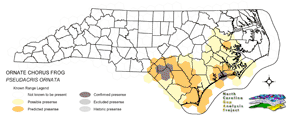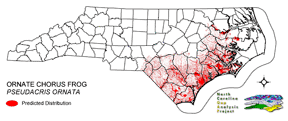
| Taxa: |
| Order: |
| Family: |
| Amphibia |
| Anura |
| Hylidae |
| NatureServe Global Rank: |
| NatureServe State (NC) Rank: |
| G5 |
| S3 |
| Federal Status: |
| NC State Status: |
| --- |
| SR |


| Land Unit |
| US Fish & Wildlife Service |
| US Forest Service |
| US National Park Service |
| US Department of Defense |
| NC State Parks |
| NC University System |
| NC Wildlife Res. Com. |
| NC Forest Service |
| NC Div. of Coastal Mgmt. |
| Local Governments |
| Non-Governmental Org. |
| Other Public Lands |
| Private Lands |
| GAP Status 1-2 |
| All Protected Lands |
| Statewide |
| Hectares |
| 14,492.25 |
| 48,969.81 |
| 46,232.37 |
| 10.35 |
| 4,799.70 |
| 19,405.17 |
| 42,114.69 |
| 8,011.53 |
| 19.62 |
| 116.46 |
| 15,869.43 |
| 438.66 |
| 844,900.20 |
| 76,182.93 |
| 199,862.01 |
| 1,045,380.24 |
| Acres |
| 35,811.12 |
| 121,007.01 |
| 114,242.65 |
| 25.58 |
| 11,860.31 |
| 47,951.21 |
| 104,067.65 |
| 19,796.92 |
| 48.48 |
| 287.78 |
| 39,214.21 |
| 1,083.95 |
| 2,087,793.46 |
| 188,252.08 |
| 493,869.69 |
| 2,583,190.33 |
| % of Dist. on |
| Prot. Lands |
| 7.3 % |
| 24.5 % |
| 23.1 % |
| < 0.1 % |
| 2.4 % |
| 9.7 % |
| 21.0 % |
| 4.0 % |
| < 0.1 % |
| 7.9 % |
| 7.9 % |
| < 0.1 % |
| 0.0 % |
| 38.1 % |
| ----- |
| ----- |
| % of Dist. on |
| All Lands |
| 1.4 % |
| 4.7 % |
| 4.4 % |
| < 0.1 % |
| 0.5 % |
| 1.9 % |
| 4.0 % |
| 0.8 % |
| < 0.1 % |
| < 0.1 % |
| 1.5 % |
| < 0.1 % |
| 80.8 % |
| 7.3 % |
| ----- |
| ----- |
|
Inhabits pine flatwoods and bottomland hardwoods surrounding breeding pools (Wilson 1995), also pine savannas and swamps (Martof et al. 1980). Can be found in upland sites, farther from water than other tree frogs typically travel. Breed at shallow, grass-rimmed pools in upland pine forest or at swampy forest pools with margins of sphagnum moss or grass
(Wilson 1995). Vernal ponds, ditches, potholes, flooded fields, Carolina bays and flooded bottomland hardwoods are all used as breeding sites (Wilson 1995). Little known about adult habits; suggested to be more fossorial than other tree and chorus frogs(Carr 1940). NATURE SERVE GLOBAL HABITAT COMMENTS: Pine flatwoods, habitats surrounding breeding pools. Burrows into ground when inactive. Eggs and larvae develop in flooded fields and ditches, pine barren ponds, and cypress ponds. |
| Code | Name | Description | NC Natural Heritage Program Equivalent |
| 75 | Tidal Swamp Forest | Swamp tupelo dominated forest with or without black tupelo and/or cypress trees. Restricted to the tidal zones in the coastal plain. May have inclusions of coastal red cedar woodlands. | Tidal cypress - gum swamp |
| 50 | Coastal Plain Mixed Bottomland Forests | Includes forests dominated by a variety of hardwood species, including sweetgum, cottonwood, red maple. | Coastal Plain Bottomland Hardwood (in part), Coastal Plain Levee Forest |
| 49 | Coastal Plain Oak Bottomland Forest | Bottomland forests dominated by deciduous oak alliances. Oaks represented can include swamp chestnut, cherrybark, willow, and/or overcup oak. Inclusions of loblolly pine temporarily flooded forests occur in patches. Hydrology is temporarily to seasonally flooded. | Coastal Plain Bottomland Hardwoods (in part) blackwater subtype, brownwater subtype |
| 158 | Coastal Plain Nonriverine Wet Flat Forests | Loblolly pine - Atlantic white-cedar - red maple - swamp tupelo saturated forests as well as forests dominated by loblolly, sweetgum, and red maple in non-riverine flats. | Non-riverine Wet Hardwood Forest |
| 41 | Peatland Atlantic White-Cedar Forest | Dense stands of Atlantic white cedar with saturated hydrology. Can include swamp tupelo, red maple, and pond pines with a moderate shrub and herb layer. | Peatland Atlantic White-Cedar Forest |
| 15 | Seepage and Streamhead Swamps | Includes extensive peat flats in the coastal plain, dominated by swamp tupelo, maples, and Atlantic white cedar alliances. In the sandhills includes streamhead pond pine and bay forests alliances. Saturated hydrology. | Bay Forest, Small Depression Pocosin, Streamhead Atlantic White Cedar Forest, Streamhead Pocosins |
| 30 | Cypress-Gum Floodplain Forests | Swamps dominated by black or swamp tupelo with or without Taxodium. Seasonally to semi-permanently flooded hydrology. | Cypress-Gum Swamps |
| 78 | Pond-Cypress - Gum Swamps, Savannas and Lakeshores | Cypress dominated swamps and lakeshores. Can include bays dominated by pond cypress or shorelines of coastal plain lakes with a narrow band of cypress. | Non-riverine Swamp Forest, Natural Lakeshores (in part) |
| 385 | Oak Bottomland Forest and Swamp Forest | The swamp chestnut oak, cherrybark oak, shumard oak and sweetgum alliance is one representative. Other alliances are dominated by water, willow, and overcup oaks. Swamp forests can be dominated by sweetgum, red maple, and black gum being dominant. Loblolly can occur in combination with sweetgum and red maple, or with tulip poplar. Includes saturated and semi- to permanently flooded forests in the mountains. | Piedmont/Mountain Bottomland Forest, Piedmont/Mountain Swamp Forest |
| 87 | Pocosin Woodlands and Shrublands | Includes pond pine woodland, low pocosin and high pocosin shrub dominated areas. Canebrakes and bay forests may be present. | Pond Pine Woodlands, Peatland Canebrake, Small Depression Pocosin |
| 67 | Wet Longleaf or Slash Pine Savanna | Wet flatwoods and pine savannas, typically dominated by longleaf pines, but slash or pond pines may be the dominant pines. | Wet Pine Flatwoods |
| 97 | Mesic Longleaf Pine | Longleaf pine woodlands without a major scrub oak component. Slash or loblolly pines may be present as well. | Mesic Pine Flatwoods |
| 384 | Piedmont/Mountain Mixed Bottomland Hardwood Forests | Includes temporarily to seasonally forests dominated by hardwood species. Hardwoods include sweetgum, red maple, sycamore which co-occur in a mosaic of bottomland and levee positions. Includes alluvial hardwood forests in the mountains. Hemlock and white pine may occur as inclusions, but are generally mapped separately. | Piedmont/Mountain Alluvial Forest, Piedmont/Mountain Levee Forest |
|
Carr, A. F., Jr. 1940. A contribution to the herpetology of Florida. Univ. Florida Biol. Sci. Ser. 3:1.118.
Wilson, L. A. 1995. The Land Manager's Guide to the amphibians and reptiles of the South. Chapel Hill, NC: The Nature Conservancy. Cocroft, R. B. 1994. A cladistic analysis of chorus frog phylogeny (Hylidae:PSEUDACRIS). Herpetologica 50:420-437. Conant, R. 1975. A Field Guide to Reptiles and Amphibians of Eastern and Central North America. Second Edition. Houghton Mifflin Company, Boston, Massachusetts. xvii + 429 pp. Mount, R. H. 1975. The Reptiles and Amphibians of Alabama. Auburn University Agricultural Experiment Station, Auburn, Alabama. vii + 347 pp. Behler, J. L., and F. W. King. 1979. The Audubon Society field guide to North American reptiles and amphibians. Alfred A. Knopf, New York. 719 pp. Martof, B. S., W. M. Palmer, J. R. Bailey, and J. R. Harrison, III. 1980. Amphibians and reptiles of the Carolinas and Virginia. University of North Carolina Press, Chapel Hill, North Carolina. 264 pp. Caldwell, J. P. 1987. Demography and life history of two species of chorus frogs (Anura:Hylidae) in South Carolina. Copeia 1987:114-127. Pechmann, J. H. K., et al. 1991. Declining amphibian populations:the problem of separating human impacts from natural fluctuations. Science 253:892-895. |
For more information please contact them at:
NC-GAP Analysis Project
Dept. of Zoology, NCSU
Campus Box 7617
Raleigh, NC 27695-7617
(919) 513-2853
www.basic.ncsu.edu/ncgap